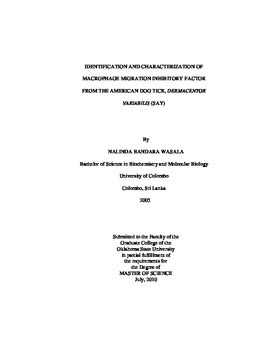| dc.contributor.author | Wasala, Nalinda Bandara | |
| dc.date.accessioned | 2014-04-15T21:16:57Z | |
| dc.date.available | 2014-04-15T21:16:57Z | |
| dc.date.issued | 2010-07-01 | |
| dc.identifier.uri | https://hdl.handle.net/11244/9019 | |
| dc.description.abstract | This study identified and characterized macrophage migration inhibitory factor (MIF) from the American dog tick, Dermacentor variabilis. The gene expression, protein level changes and function of MIF was studied using a number of biochemical and molecular biology methods. The study further identified the phylogenetic relationship of MIF from different species using high throughput bioinformatics tools. The current study has identified and characterized the full length cDNA sequence of the macrophage migration inhibitory factor (MIF) from the American dog tick, D. variabilis and an up-regulation of the MIF gene expression during 0-96 hrs fed female D. variabilis ticks in both salivary glands and midgut tissues. The highest level of MIF expression was observed in midgut compared to the salivary glands. In contrast, the change in protein levels found in salivary glands and midgut tissues declined as the feeding progressed from 0-96 hrs. RNAi mediated gene silencing of D. variabilis MIF was shown to down-regulate the expression approximately by 90% compared to the buffer-injected controls in the salivary gland and midgut but gene silencing has not shown a negative impact on the ticks' ability to uptake blood meal. In both salivary gland and midgut, subolesin dsRNA injection down-regulated the MIF expression approximately by 50% compared to the buffer-injected control. The bioinformatics analysis showed the across species conservation of the MIF amino acid sequence in ticks, nematodes and insects. The phylogenetic analysis revealed that tick MIFs share a close evolutionary proximity to some parasitic nematode MIFs rather than insect MIF. The homology modeling identified the closest D. variabilis MIF homolog available by the analysis was performed was from T. spiralis and the identified model and D. variabilis shared the same highly conserved amino acids. | |
| dc.format | application/pdf | |
| dc.language | en_US | |
| dc.publisher | Oklahoma State University | |
| dc.rights | Copyright is held by the author who has granted the Oklahoma State University Library the non-exclusive right to share this material in its institutional repository. Contact Digital Library Services at lib-dls@okstate.edu or 405-744-9161 for the permission policy on the use, reproduction or distribution of this material. | |
| dc.title | Identification and Characterization of Macrophage Migration Inhibitory Factor from the American Dog Tick, Dermacentor Variabilis (Say) | |
| dc.type | text | |
| osu.filename | Wasala_okstate_0664M_11029.pdf | |
| osu.college | Agricultural Sciences and Natural Resources | |
| osu.accesstype | Open Access | |
| dc.description.department | Department of Entomology and Plant Pathology | |
| dc.type.genre | Thesis | |
| dc.subject.keywords | dermacentor variabilis | |
| dc.subject.keywords | gene expression | |
| dc.subject.keywords | macrophage migration inhibitory factor (mif) | |
| dc.subject.keywords | midgut | |
| dc.subject.keywords | salivary glands | |
| dc.subject.keywords | subolesin | |
